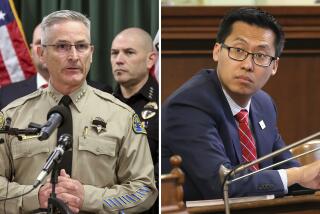Governors Map Plans to Help Clinton : Policy: Bipartisan gathering voices willingness to work with Administration on reducing deficit.
Fourteen of the nation’s governors and dozens of local officials met behind closed doors here Thursday to develop strategies for assisting the Clinton Administration in policy-making decisions aimed at jump-starting the economy and reducing the federal deficit.
The bipartisan gathering of governors, mayors, county commissioners and business leaders, led by Colorado Gov. Roy Romer, lasted seven hours. It culminated in the drafting of a position paper forwarded to President-elect Bill Clinton.
Romer, a Democrat, declined to discuss the contents of the paper except to say: “We want to roll up our sleeves and say, ‘We want to help because Mr. President and Congress, you have a real problem to face.’ ”
“We must work shoulder-to-shoulder with the Congress and the President to reduce the deficit over the next five years,” Romer said. “So we’ve agreed to stay together as a consortium that will continue to act collectively to be a part of the solution.”
Donald Fraser, vice president of the National League of Cities, was less enthusiastic about the outcome of the meeting.
“It was a fairly modest document,” Fraser said. “Expressing our willingness to work with the Administration was the main point.”
The governors, who are in Colorado for a three-day bipartisan National Governors’ Assn. conference, fear that dramatic budget cuts and tax increases will slow the economy, increase unemployment and reduce state revenues while increasing demands on local spending.
Even with a rebounding economy and proposed defense cutbacks, state governments could not finance an expanded health care program, fund new investment proposals and significantly reduce the national deficit without major cutbacks in other federal domestic programs, according to a white paper issued at the conference.
“The No. 1 question for the first 100 days of the new Administration deals with the federal deficit and improving the economy to create jobs,” said Delaware Gov. Michael N. Castle, a Republican. “The states and federal government are spending so much of their resources on programs such as Medicaid . . . there is absolutely nothing left for infrastructure and stimulating the economy.”
Solving these problems will define federal, state and local relations well into the 21st Century, Romer said.
“We need to come to the table with a posture of being willing to make sacrifices to solve these fiscal problems,” Romer said. “Right now, we have a condition in this country in which people want services beyond our ability to pay for them.”
Meanwhile, states are bracing for rough fiscal waters. Warning signs indicate that economic growth will lag behind the 1980s expansion rate while state spending will continue to explode for health care, prisons, education and transportation, association officials said.
“No matter what Congress and the new Administration do with regard to the federal deficit, it will wind up having a profound impact on state governments,” said Rae Bond, a spokeswoman for the association, which was formed in 1908 to work with the Administration and Congress on state-federal issues.
Despite three consecutive years of cutting spending and raising taxes, states remain in economic turmoil, according to a fiscal survey of states released by the association in October.
For example, Medicaid, has grown from 8% of state budgets in 1980 to 25% in 1991, while state revenues have been growing 4% to 5% annually, the survey said.
“The national economy and state revenues are inextricably bound,” said Raymond Scheppach, the association’s executive director, in a statement issued with the October survey.
“Unlike previous economic recoveries, which witnessed 5% to 6% economic growth, the national economy is expected to grow by just 1.8% in 1992,” Scheppach said. “Until the nation is on a path of sustainable growth, states will continue to struggle.”
The association has scheduled meetings in December and February to grapple with health care and education system reforms proposed by Clinton, who chaired the organization in 1986-87.
More to Read
Get the L.A. Times Politics newsletter
Deeply reported insights into legislation, politics and policy from Sacramento, Washington and beyond. In your inbox three times per week.
You may occasionally receive promotional content from the Los Angeles Times.







